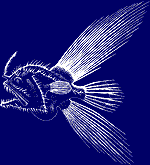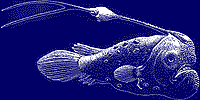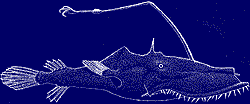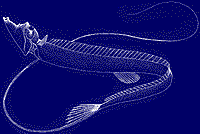
|

|

|
Deep-Sea Bestiary
Part 3
(back to Part 2)
Caulophryne polynema translates as "stalked
toad with many filaments," but with its quill-like
fin rays it looks more like some piscine porcupine.
The type specimen of this deep-sea angler was
hauled up by Madeira fishermen, who found a black,
eight-inch-long fish with a belly so distended that
it seemed the fish had swallowed an orange. Poking
from the fish's mouth was the tail of a
significantly larger fish, which was somehow
attracted by this fearsome-looking fish, possibly by
the delicately plumed lure adorning its forehead.
|

|

|
With a face only a mother could love,
Himantolophus groenlandicus looks like a
middle linebacker for the Pittsburgh Steelers, which
may have something to do with how it got its common
name, the "footballfish." The species holds
pride of place as the first deep-sea angler ever
found. The original specimen washed ashore in
Greenland in 1833; at 22 inches long, it is still
the largest one on record. Since no females of this
species have ever been found bearing parasitic
males, biologists assume they are fertilized by
free-swimming mates.
|
Once called "a grotesque among grotesques,"
Lasiognathus saccostoma has an overbite to
end all overbites. Yet this three-inch-long fish has
also been called "the compleat angler of the abyss,"
for it comes equipped with nature's equivalent of a
fishing rod, complete with lure and three bony
hooks. Though the precise function of this
contraption is unknown, the undersea explorer
William Beebe suggested in 1930 that it might be
"cast swiftly ahead, when the hooks and lights would
so frighten any pursued fish that they would
hesitate long enough to be engulfed in the onrushing
maw."
|

|

|
In the bituminous blackness of the deep sea, what an
alluring sight to a fish must be the luminescent
organ dangling from the toothy jaws of
Thaumatichthys axeli, "Prince Axel's
wonder-fish."
The first specimen of this black, 18-inch
bottom-dweller was trawled from a depth of 11,778
feet in the Atlantic by the Galathea expedition of
1950-52. The voyage's chronicler deemed the find
"unquestionably the strangest catch of the Galathea
expedition, and altogether one of the oddest
creatures in the teeming variety of the fish
world."
|
Its telescopic eyes and pair of elongated tail rays,
which triple its overall length to almost three
feet, have gained Stylephorus chordatus two
common names, "tube-eye" and
"thread-tail." Yet striking as they are,
these features hold nothing on the mouth. This
balloonable cavity can expand to 38 times its
original size as the fish sucks in seawater through
its tubular mouth, as if through a straw. Once
filled, the mouth closes and the fish forces the
water back out through its gills, leaving behind a
meal of plankton.
|

|

|
Looking like an artist's conception of the tree of
life, the
basket starfish Gorgonocephalus arcticus is
found from the Arctic to Cape Cod at depths reaching
4,000 feet. It belongs to the family
Gorgonocephalidae ("Gorgon-headed"), which is named
after the snake-haired sisters of Greek mythology.
Reaching some 20 inches across, the basket star
snags plankton in its canopy of branching arms and
ushers them to its mouth on the underside of the
center disk.
|
Peter Tyson is Online Producer of NOVA.
Living at Extremes
|
Inside a Tubeworm
|
Deep-Sea Bestiary
Images: All drawings by Richard Ellis from "Deep Atlantic;"
(1,5,7) © 1998 Norbert Wu; (9) © 1997 Norbert Wu;
(3) © 1996 Norbert Wu; (8) © 1995 Norbert Wu; (6)
© 1994 Norbert Wu.
The Mission |
Life in the Abyss |
The Last Frontier |
Dispatches
E-mail |
Resources |
Table of Contents
|
Abyss Home
Editor's Picks
|
Previous Sites
|
Join Us/E-mail
|
TV/Web Schedule
About NOVA |
Teachers |
Site Map |
Shop |
Jobs |
Search |
To print
PBS Online |
NOVA Online |
WGBH
©
| Updated October 2000
|
|
|








